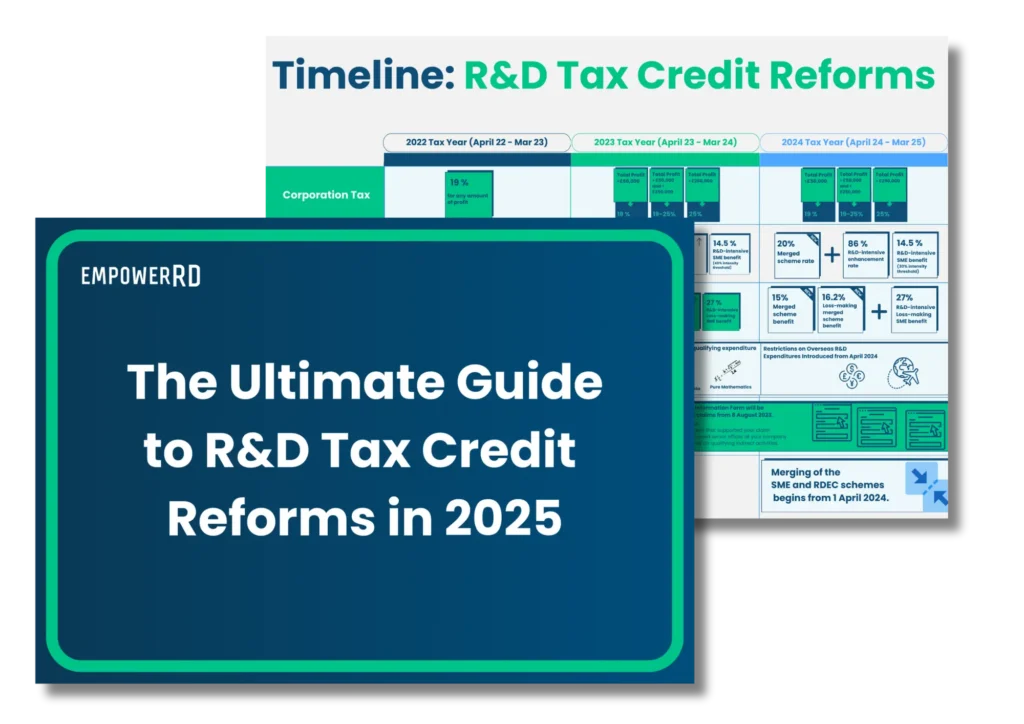August 2023 – The deadline for your R&D tax credit claim is approaching
The August 2023 deadline for submitting your amended CT600 (Corporation Tax return) is fast approaching, but you’ve got it covered. You’ve worked with the tech team to bring together the technical report and double-checked the costs again to ensure accuracy. You submit your R&D tax relief claim to HMRC with a few days to spare. The CEO gives you a pat on the back, and you get back to the long list gathering dust on your desk.
Six weeks pass and the credit still has yet to arrive
“Nothing yet,” you reply after realising the receipt is taking longer than you remember.
“Anything from HMRC yet? It would be great to get that cash soon!” your boss asks as he passes your desk.
A few days later, you receive the worst possible outcome. HMRC is writing to say you won’t receive relief for your 20/21 claim. Not because it’s been rejected but because you didn’t submit the new compulsory g-form, the Additional Information Form!
Although the worst case scenario, the situation above will happen to companies. Don’t let it happen to you! Even if you catch it before it’s too late, the new form is complex and an entirely new way of claiming R&D tax relief. It will require more information and more time to prepare. If you’re unfamiliar with the Additional Information Form, learning about it now is essential.
Don’t panic. There are steps you can take!
Read up on the information form
As per the name (Additional Form), HMRC will require additional information to process an R&D claim benefit. What exactly is this additional information?
Well, the additional information requires admin:
- Contact details of the main senior internal R&D contact in the company who is responsible for the R&D claim
- Contact details of any agent involved in the R&D claim
- VAT registration number
- Employer PAYE reference number
- Unique Taxpayer Reference (UTR)
- Identification of business type, for example, your current SIC (Standard Industrial Classification) code
- List the total amount of R&D projects in the financial year.
But then it goes into the particulars of the claim, and this is where it gets a little trickier. They ask for the following:
- A breakdown between direct and indirect qualifying R&D activities – Distinguishing between direct and indirect activities can be challenging, as difficult as it is to distinguish between indirect activity and business as usual, which is not eligible. At EmpowerRD, we’ve seen companies grapple with this grey area multiple times and fail. With the New Additional Information Form, you’ll have no choice but to succeed.
- A breakdown of the R&D costs allocated to each R&D project – You might find it challenging to itemise project costs, especially if you have no prior experience with this task. You’ve probably listed the costs but not broken them down by project. You’ll have to go into each project and break up the costs.
- A standardised set of questions for each R&D project narrative:
- What is the main field of science or technology?
- What was the baseline level of science or technology that you planned to advance?
- What advance in that scientific or technical knowledge did you aim to achieve?
- What scientific or technological uncertainties did you face?
- How did your project seek to overcome these uncertainties?
For an inexperienced claimer, it can be difficult to understand the technical terms and produce such comprehensive technical reports. The Additional Information Form’s fixed questionnaire is likely to be perplexing for those who aren’t specialists, especially regarding terms such as scientific or technological uncertainties. So it’s important to do your homework.
If you want to learn more or understand the differences between the old claiming method and the new Additional Information Form, you can read our easy-to-digest guide. Another option is to refer to HMRC’s guidance.
Reassess the way you claim
Self-assess: If you make your claim in-house, ask yourself if the new process is similar to how you’ve been claiming. If adopting the new process is more demanding than your current one and requires more time, it’s important to evaluate the potential risks. Is it worth getting involved if there’s a chance to make an error and be subject to a lengthy enquiry? If it’s not, it might be a good idea to seek assistance from an R&D specialist. A specialist’s process is more aligned with the new method implemented by HMRC.
Accountant: If you’ve been working with an accountant, ask them about the new Additional Information Form. Accountants have a lot on their plate, and R&D tax relief is not their specialist area of expertise, so they can miss these things. If they appear vague or haven’t heard about it, this demonstrates a lack of knowledge, which isn’t a good sign and will affect your ability to claim.
Existing Provider: Not all service providers are the same, and many lack the necessary knowledge. Again, if they appear vague, have yet to hear about it or brush it off as nothing big, this isn’t a good sign for your next claim.
At EmpowerRD, we think it’s a big thing, and we’re prepared!
Since discovering the Additional Information Form, EmpowerRD has made several changes to its operations. Though our procedures align closely with the new requirements, our tech and tax teams have worked hard to ensure that our software + services are fully equipped for this new approach. As a result, we are confident that our client’s claims will remain both compliant and optimised come 8 August 2023.
Seeking a trusted partner to help you build your R&D tax claim?
We’re here to help. Over 1000 UK companies have trusted EmpowerRD’s R&D platform and specialists to help them build optimised, compliant R&D tax claims. Please get in touch with one of our experts today if you have any further questions.












